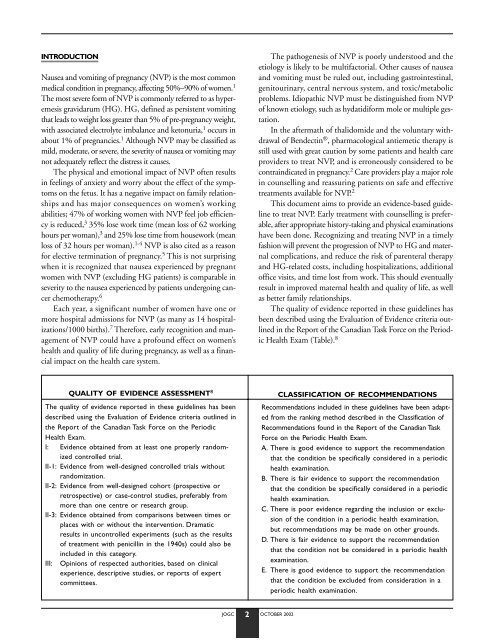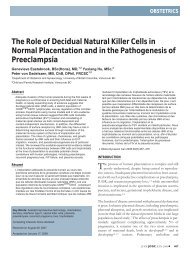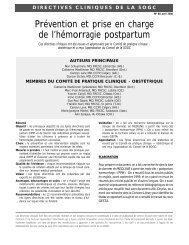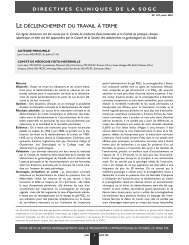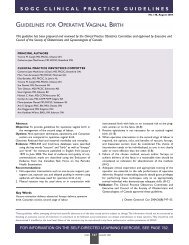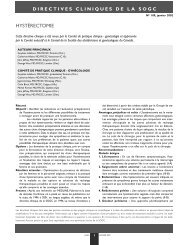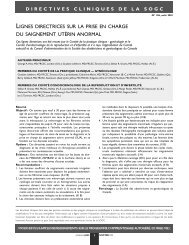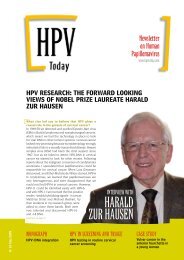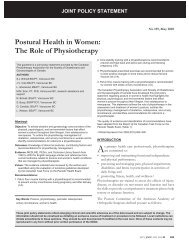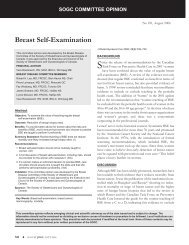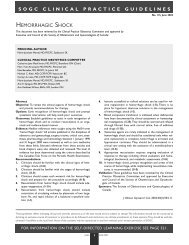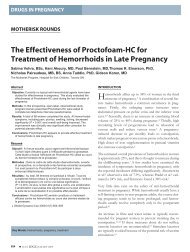The Management of Nausea - SOGC
The Management of Nausea - SOGC
The Management of Nausea - SOGC
You also want an ePaper? Increase the reach of your titles
YUMPU automatically turns print PDFs into web optimized ePapers that Google loves.
INTRODUCTION<br />
<strong>Nausea</strong> and vomiting <strong>of</strong> pregnancy (NVP) is the most common<br />
medical condition in pregnancy, affecting 50%–90% <strong>of</strong> women. 1<br />
<strong>The</strong> most severe form <strong>of</strong> NVP is commonly referred to as hyperemesis<br />
gravidarum (HG). HG, defined as persistent vomiting<br />
that leads to weight loss greater than 5% <strong>of</strong> pre-pregnancy weight,<br />
with associated electrolyte imbalance and ketonuria, 1 occurs in<br />
about 1% <strong>of</strong> pregnancies. 1 Although NVP may be classified as<br />
mild, moderate, or severe, the severity <strong>of</strong> nausea or vomiting may<br />
not adequately reflect the distress it causes.<br />
<strong>The</strong> physical and emotional impact <strong>of</strong> NVP <strong>of</strong>ten results<br />
in feelings <strong>of</strong> anxiety and worry about the effect <strong>of</strong> the symptoms<br />
on the fetus. It has a negative impact on family relationships<br />
and has major consequences on women’s working<br />
abilities; 47% <strong>of</strong> working women with NVP feel job efficiency<br />
is reduced, 3 35% lose work time (mean loss <strong>of</strong> 62 working<br />
hours per woman), 3 and 25% lose time from housework (mean<br />
loss <strong>of</strong> 32 hours per woman). 1-4 NVP is also cited as a reason<br />
for elective termination <strong>of</strong> pregnancy. 5 This is not surprising<br />
when it is recognized that nausea experienced by pregnant<br />
women with NVP (excluding HG patients) is comparable in<br />
severity to the nausea experienced by patients undergoing cancer<br />
chemotherapy. 6<br />
Each year, a significant number <strong>of</strong> women have one or<br />
more hospital admissions for NVP (as many as 14 hospitalizations/1000<br />
births). 7 <strong>The</strong>refore, early recognition and management<br />
<strong>of</strong> NVP could have a pr<strong>of</strong>ound effect on women’s<br />
health and quality <strong>of</strong> life during pregnancy, as well as a financial<br />
impact on the health care system.<br />
QUALITY OF EVIDENCE ASSESSMENT 8<br />
<strong>The</strong> quality <strong>of</strong> evidence reported in these guidelines has been<br />
described using the Evaluation <strong>of</strong> Evidence criteria outlined in<br />
the Report <strong>of</strong> the Canadian Task Force on the Periodic<br />
Health Exam.<br />
I: Evidence obtained from at least one properly randomized<br />
controlled trial.<br />
II-1: Evidence from well-designed controlled trials without<br />
randomization.<br />
II-2: Evidence from well-designed cohort (prospective or<br />
retrospective) or case-control studies, preferably from<br />
more than one centre or research group.<br />
II-3: Evidence obtained from comparisons between times or<br />
places with or without the intervention. Dramatic<br />
results in uncontrolled experiments (such as the results<br />
<strong>of</strong> treatment with penicillin in the 1940s) could also be<br />
included in this category.<br />
III: Opinions <strong>of</strong> respected authorities, based on clinical<br />
experience, descriptive studies, or reports <strong>of</strong> expert<br />
committees.<br />
1<br />
<strong>The</strong> pathogenesis <strong>of</strong> NVP is poorly understood and the<br />
etiology is likely to be multifactorial. Other causes <strong>of</strong> nausea<br />
and vomiting must be ruled out, including gastrointestinal,<br />
genitourinary, central nervous system, and toxic/metabolic<br />
problems. Idiopathic NVP must be distinguished from NVP<br />
<strong>of</strong> known etiology, such as hydatidiform mole or multiple gestation.<br />
In the aftermath <strong>of</strong> thalidomide and the voluntary withdrawal<br />
<strong>of</strong> Bendectin ® , pharmacological antiemetic therapy is<br />
still used with great caution by some patients and health care<br />
providers to treat NVP, and is erroneously considered to be<br />
contraindicated in pregnancy. 2 Care providers play a major role<br />
in counselling and reassuring patients on safe and effective<br />
treatments available for NVP. 2<br />
This document aims to provide an evidence-based guideline<br />
to treat NVP. Early treatment with counselling is preferable,<br />
after appropriate history-taking and physical examinations<br />
have been done. Recognizing and treating NVP in a timely<br />
fashion will prevent the progression <strong>of</strong> NVP to HG and maternal<br />
complications, and reduce the risk <strong>of</strong> parenteral therapy<br />
and HG-related costs, including hospitalizations, additional<br />
<strong>of</strong>fice visits, and time lost from work. This should eventually<br />
result in improved maternal health and quality <strong>of</strong> life, as well<br />
as better family relationships.<br />
<strong>The</strong> quality <strong>of</strong> evidence reported in these guidelines has<br />
been described using the Evaluation <strong>of</strong> Evidence criteria outlined<br />
in the Report <strong>of</strong> the Canadian Task Force on the Periodic<br />
Health Exam (Table). 8<br />
JOGC 2 OCTOBER 2002<br />
CLASSIFICATION OF RECOMMENDATIONS<br />
Recommendations included in these guidelines have been adapted<br />
from the ranking method described in the Classification <strong>of</strong><br />
Recommendations found in the Report <strong>of</strong> the Canadian Task<br />
Force on the Periodic Health Exam.<br />
A. <strong>The</strong>re is good evidence to support the recommendation<br />
that the condition be specifically considered in a periodic<br />
health examination.<br />
B. <strong>The</strong>re is fair evidence to support the recommendation<br />
that the condition be specifically considered in a periodic<br />
health examination.<br />
C. <strong>The</strong>re is poor evidence regarding the inclusion or exclusion<br />
<strong>of</strong> the condition in a periodic health examination,<br />
but recommendations may be made on other grounds.<br />
D. <strong>The</strong>re is fair evidence to support the recommendation<br />
that the condition not be considered in a periodic health<br />
examination.<br />
E. <strong>The</strong>re is good evidence to support the recommendation<br />
that the condition be excluded from consideration in a<br />
periodic health examination.


